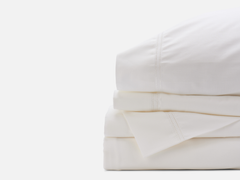Last week we were able to travel up to Gaffney, South Carolina and get a glimpse of our Red Land Cotton fabric being woven on the loom. It was surreal seeing our cotton yarn transform into cloth. They let us snag a few pictures and we're dying to show you!
* Disclaimer: We are in no way textile engineers. We will be showing and explaining this process per our basic knowledge of it! Enjoy!
So last time we talked about our process we were spinning our yarn. That yarn was wound onto large bobbins and sent to the weaver. From there the yarn will be used as either a warp or a weft yarn. Or as I like to think of it as "the frame" and "the filling". Hopefully, this will make more sense soon.
the warp yarns
The warp yarns run lengthwise. The warp yarns are wound from their original bobbins onto a large "warp beam" (ie. massive metal spool of yarn). This process is visually stunning (we didn't get a picture of our own but it looks like this). It takes between 2,000-5,000 warp yarns to make up the width of a single sheet. 500-600 ends of yarn from spools are pulled onto the large metal beam, thus "warping" it.



After the warp beams are filled they go into "slashing" which consists of coating the warp yarns with a starch or sizing solution that makes the yarns easier to weave. Because the warp yarns are the "frame" for our cloth, they will experience a lot of friction and a bit of a rougher time than the weft or "filling" yarn. All the coating comes off in the finishing process. From there, the sized yarns are wound onto loom beams and placed on the loom.



the weft yarns
Weft yarns run across the width of the fabric and serves as a "filling" of sorts to the fabric as a whole. The weft doesn't have to be sized because flexibility is actually needed from the weft yarns in the weaving process. The weft is fed directly from the spools of yarn onto the loom at a very high speed.




weaving on the loom
Weaving involves the weft threads interlocking with the warp threads. The filler threads are transported across the warp threads at a rate of around 500 insertions per minute! This means that a filler thread can run across the warp thread about every one-tenth of a second. It takes about 90 insertions to weave an inch of sheeting! SO thats about 5.5 inches of sheeting woven per minute — 10 yards per hour. Every week the loom can produce about 1,500 yards of fabric. The woven product is referred to as "greige" or "grey goods" and will go on to finishing after thorough inspection for any imperfections.











